A városi logisztikai szolgáltatók, a családi motorosok és a kereskedelmi flották vásárlói számára egyaránt a motor nyomatéka az egyik legfontosabb jellemző, amely meghatározza, hogy a teherbicikli milyen jól teljesít terhelés alatt. De mennyi nyomaték az elég - és mi a túl sok? Az Regen-nél ezt gyakorlati példákkal és mérnöki meglátásokkal bontjuk le az Ön számára.
Korábban már írtunk egy cikket a 20 GYIK a motor nyomatékáról a Cargo Bike számára, amely megválaszolja a legtöbb alapvető kérdést ezzel az alkatrésszel kapcsolatban. Ha érdekel, elolvashatod.
Mi a motor nyomatéka a Cargo Bike számára?
A nyomaték a motor által termelt - newtonméterben (Nm) mért - forgatóerő. Az elektromos teherbicikliknél ez közvetlenül befolyásolja a gyorsulást, a mászóerőt és azt, hogy a kerékpár mennyire egyenletesen mozog nehéz terhek alatt.
Nagyobb nyomaték = jobb hegymászás, nagyobb vontatási teljesítmény
Alacsonyabb nyomaték = jobb energiahatékonyság és akkumulátor hatótávolság (könnyű terhelés esetén)
Az e-kerékpárok tipikus hatótávolsága:
| E-kerékpár típusa | Nyomatéktartomány (Nm) |
|---|---|
| Normál városi e-bike | 35-50 Nm |
| Trekking/túra e-bike | 50-65 Nm |
| Cargo e-bike | 65-100+ Nm |
Szeretné megérteni az e-cargo teljesítményét befolyásoló egyéb kulcsfontosságú jellemzőket? Tekintse meg A Cargo Bike legfontosabb összetevői útmutatót a teljes bontásért.
Hogyan befolyásolja a nyomaték a valós világ teherforgalmi kerékpár használatát?
1. Városi családi lovasok
Ha 1-2 gyereket vagy könnyű élelmiszert szállít az első dobozban:
- Ajánlott nyomaték: 60-70 Nm
- Miért? Elegendő ahhoz, hogy a dombokat és a forgalmi megállókat túlzott akkumulátor-elvonás nélkül kezelje.
- Példa: Egy Long John teherbicikli a középhajtású 65 Nm-es motorral könnyedén kezeli a mindennapi iskolai és bevásárlókörutakat - még 10-12% körüli lejtőkön is.
2. Kereskedelmi szállítások (könnyű és közepes terhek)
150 kg összterhelés (lovas + rakomány) alatti utolsó mérföldes szállításokhoz:
- Ajánlott nyomaték: 70-85 Nm
- Miért? Lehetővé teszi a stop-and-go szállításokat stabilitás és kisebb pedálterhelés mellett.
- Példa: A 250 W-os motorral és 80 Nm nyomatékkal rendelkező kézbesítő kerékpár hatékonyan teljesíti a mérsékelt emelkedőkkel és többszöri leállással járó belvárosi útvonalakat.
3. Nehéz teherszállítási logisztika
Ha >200 kg-ot szállít (pl. ipari termékek, nagyméretű élelmiszertartályok):
- Ajánlott nyomaték: 85-100+ Nm
- Miért? Meredek rámpákhoz, felüljárókhoz és nagy súly alatti sima elinduláshoz szükséges.
- Példa: A 120 Nm nyomatékkal rendelkező 3 kerekű teherbringa akár 300 kg hasznos terhet is elbír minimális vezetői ráfordítással, így ideális önkormányzati vagy B2B alkalmazásokhoz.
Front Hub vs. Mid-Drive: A nyomaték érzése más?
Igen - a nyomatékértékek különbözőek attól függően, hogy a motor hova fejti ki az erőt.
| Motor típusa | Nyomaték (Nm) | Valós világ érzés |
|---|---|---|
| Első kerékagy | 35-60 | Közvetlen húzás, gyengébb a dombokon, jó sík terepen |
| Középhajtás | 60-100+ | Erősebbnek érződik a fogaskeréknek köszönhetően, nagyszerű a lejtőkön |
| Hátsó kerékagy | 45-80 | Kiegyensúlyozott opció; jó kétkerekűek számára mérsékelt terheléssel |
Nyomaték vs. teljesítmény: Mi a fontosabb?
| Spec | Intézkedések | A Cargo Bikes fontossága |
|---|---|---|
| Teljesítmény | Energia az idő múlásával (W) | Hatás a végsebességre |
| Nyomaték | Forgási erő (Nm) | Hatás a terheléskezelésre, gyorsulásra, hegymászásra |
Teherbiciklikhez, a nyomaték többet számít, mint a puszta teljesítmény - különösen terhelés alatti indításkor vagy mászáskor. Egy 250 W-os, 85 Nm nyomatékú motor meredek emelkedőkön felülmúlhat egy 500 W-os, mindössze 40 Nm nyomatékú kerékagymotor teljesítményét.
Hogyan válasszuk ki a megfelelő nyomatékszintet a felhasználási esethez?
| Használati eset | Ideális nyomatéktartomány | Motor típusa |
|---|---|---|
| Iskolába járás, bevásárlás | 60-70 Nm | Középhajtás |
| Városi futár (közepes rakományok) | 70-85 Nm | Középső vagy hátsó kerékagy |
| Logisztika (200 kg+) | 85-120+ Nm | Középhajtás, gyakran kettős akkumulátorral |
| Dombos terep + rakomány | 80-100 Nm | Nagy hatékonyságú középhajtás |
Szeretné a hosszú távú költségeket is alacsonyan tartani? Olvassa el, hogyan Csökkentse a karbantartási költségeket a moduláris alkatrészválasztással a Cargo Bike tervezésében.
Segítségre van szüksége a döntésben? Az Regen ingyenes nyomatékegyeztető konzultációkat kínál
A megfelelő nyomaték kiválasztása nem csak a számról szól, hanem arról is, hogy a teherbringa hogyan integrálja a vázgeometriát, a hasznos terhelést, a terepet és a motorrendszert.
Az Regen-nél mérnöki és azonosító csapatunk szorosan együttműködik a B2B partnerekkel, hogy a motor specifikációit a valós szállítási forgatókönyvekhez igazítsa. Akár bérbeadó flottát épít, akár márkás szállítási megoldást indít, szimulálni tudjuk a terhelést, a lejtéseket és a használati frekvenciát, hogy javaslatot tegyünk az ideális nyomatékbeállításra.
Elérhet minket a következő elérhetőségeken videóhívás, e-mail vagy telefon - még egy minta beállítási vázlat kérésre.
👉 Lépjen kapcsolatba velünk a kezdéshez
Következtetés: A nyomaték egyensúlya a valós igényekkel
A teherbiciklik nyomatékválasztására nincs egyféle válasz. A lényeg a rakomány profiljának, az útvonal magasságának és a kerékpáros elvárásainak megértése - és a motor nyomatékteljesítményének ennek megfelelő beállítása. A túlzott nyomaték pazarolja az energiát; az alulnyomaték a motoros fáradtságát és gyenge teljesítményét okozza.
Az Regen tapasztalatával egyedi kerettervezés és középhajtású rendszer integrálása, segítünk partnereinknek megtalálni a teljesítmény és a hatékonyság közötti ideális pontot.
Hivatkozási lista (APA stílus)
- Bosch eBike Systems. (n.d.). Performance Line és Cargo Line motor specifikációk. Retrieved July 8, 2025, from https://www.bosch-ebike.com.
- Bafang Electric. (n.d.). M620 Ultra meghajtórendszer. Retrieved July 8, 2025, from https://www.bafang-e.com.
- Shimano STEPS. (n.d.). E6100 és EP8 motorplatform teher- és túra e-kerékpárokhoz. Visszakeresve a https://bike.shimano.com oldalról.
- Európai Szabványügyi Bizottság. (2023). EN 17860-1:2023: Kerékpárok - Elektromos segédmotoros kerékpárok - EPAC teherkerékpárok. Brüsszel: CEN.
- Elektromos kerékpár jelentés. (2023). Nyomaték vs. teljesítmény: mi a fontosabb az e-kerékpárok esetében? Visszakeresve a https://electricbikereport.com oldalról.
- Ebike School. (n.d.). Az elektromos kerékpármotorok nyomatékának megértése. Retrieved July 8, 2025, from https://www.ebikeschool.com.
- Rad Power Bikes. (n.d.). Elektromos teherbicikli vásárlási útmutató. Visszakeresve a https://www.radpowerbikes.com oldalról.
- REI Co-op. (2024). Hogyan válasszunk egy elektromos teherbiciklit. Visszakeresve a https://www.rei.com/learn/expert-advice/electric-cargo-bikes.html oldalról.







